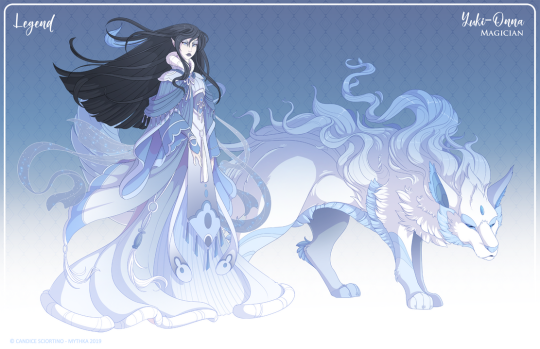#involutionist
Explore tagged Tumblr posts
Text
Involutionist (Spiritualist Archetype)

(art by Mythka on DeviantArt)
To understand oneself, one must deconstruct oneself, examining the truth of each part and how they fit together into the greater whole.
In the Rivethun spiritual tradition, members typically examine the dualities and inconsistencies within themselves to become closer to other “in-between” beings like spirits, bonding with them in various ways. Most become shamans, but there is plenty of different ways to express their philosophy both in the fluff and crunch of the game.
While most pay homage to naturally-occuring spirits, today’s subject, the involutionist, instead creates a new spirit, partitioning off a portion of their own soul and mind into a being that is at once a part of them, but also a separate being. The bond between them is so strong that they have no choice but to focus on it to the exclusion of traditional shamanistic activities of calling upon local spirits and the like.
Now, this is not the first time we’ve seen a spiritualist archetype that is all about the spiritualist phantom being a literal part of their psyche (see the fractured mind archetype), but unlike the fractured mind, this seems like a more deliberate process, and one marked by the filter of divine magic, similar to the onmyoji archetype.
Additionally, since these phantoms have the qualities of the spirits normally called upon by shamans, they are under no obligation to resemble humanoids when manifested, instead reflecting the nature of their aspect.
It’s also worth noting that this archetype has elements not just of the concept of tulpas, but also plurality. Now, as a singlet myself, I can’t claim to have any authority on the matter, but having multiple distinct selves that can communicate with each other is a rich area for some positive representation in this poorly understood area, methinks.
As mentioned above, these spiritualists cast the same sort of spells as their kin, but use divine magic instead of psychic magic. What’s more, their phantoms serve as their divine focus, requiring that the phantom be inside their consciousness or nearby to be able to cast spells.
Rather than have an emotional focus like other phantoms, their spiritual allies instead invoke an aspect similar to a shaman’s spirit. The phantom provides aptitude in appropriate skills, but also are able to manifest the same blessings that a shaman’s familiar would benefit from that spirit, as well as gain various hexes associated with that spirit type.
Naturally, the spiritualist can use these abilities as well when the phantom manifests partially through them as well.
This method also lends itself to sensing auras, allowing the mystic to sense the auras on people and objects and understand their significance.
Finally, their limited ability to communicate with spirits other than their companion improves in a startling way, allowing them to give life to nearby objects by investing a bit of themselves in them.
Having a phantom with hexes instead of an emotional focus is a neat idea, but it does mean that you’re probably gonna build them more as bodyguards and secondary casters than having them wade into melee alone or alongside the spiritualist, especially since the mage themselves cannot cast most of their spells when the phantom isn’t beside them, which is a similar problem to what the shadow caller archetype has, without the extreme penalty for not moving together but without a way to get around their problem the way the shadow caller can with darkness spells. I personally would build these spiritualists for a back to mid-line role controlling the battlefield and buffing up before moving in, if at all. However, I know there are some hexes in certain shaman spirits that buff melee ability, so keep in mind that it’s a possibility.
When I talked about deconstructing yourself at the beginning of the entry, I neglected to mention the final step of that process: putting oneself together again. After all, once you’ve analyzed yourself, the only thing left to do is reconstruct, but that doesn’t mean putting oneself back together in the same way. One can choose to focus on developing different parts of the self and minimizing others, after all, and it begins with the decision to do so. This is much more literal when parts of yourself include whole other entities. As such, some involutionists may seek to forge their phantom spirit from something they don’t like about themselves to put some distance between themselves and what they represent, or they may make them purely as an expression of self-love and examination. Others still may use it to examine themselves and, in one of those rare instances where retraining makes sense, reabsorb their phantom to form a new one with a different aspect in mind.
Bitter about the damage caused by human loggers but also wishing to find forgiveness for humanity as a whole, Rashai has undergone exercises to manifest her anger into a phantom being, a human-sized fox-like embodiment of nature whose breath rusts axes and crumbles constructs alike.
Fascinated by monsters of truly colossal size, such as kaiju, Shoka longs to witness and study such creatures ever since one of the massive “deadly mantises” was sighted in the jungle valley. Perhaps it’s no surprise that his desire manifested as a towering kaiju of flame… in miniature, standing no higher than a human.
The mind has limits. One can only go through so much before something either breaks or one finds a way to shed the stress. That is what happened to the person once known as Korrad of Tolmus after his family was slain and his business ruined, he had had enough, and was no more. Now, in his place is Yaniel, and her companion, the phantom Echo, a shadow of her memories of her family.
6 notes
·
View notes